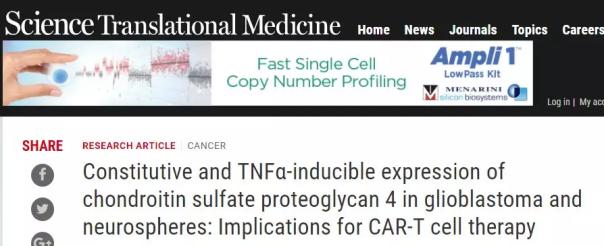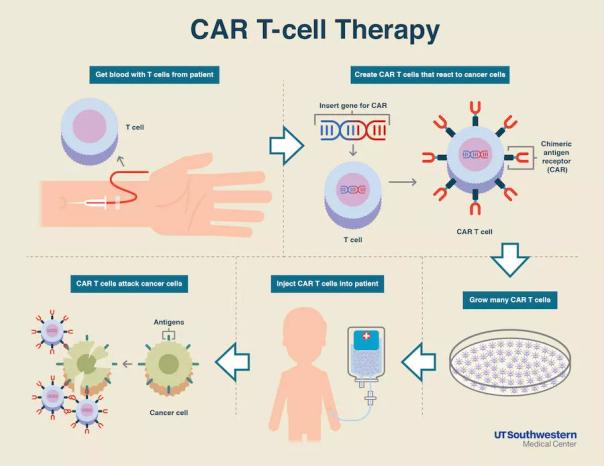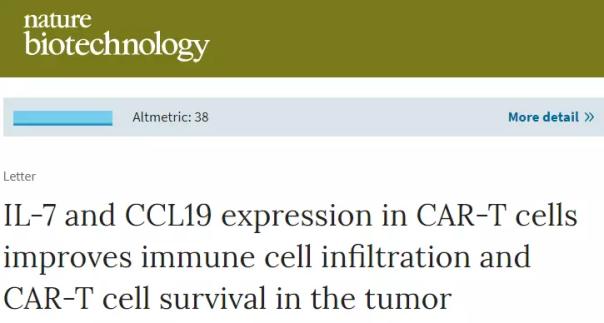The breakthrough results of CAR-T therapy "followed"
Release date: 2018-03-09
Editor's note
Recently, CAR-T therapy has achieved breakthrough results in succession! First, a team of scientists from the United States and Italy found a better target for CAR-T against a deadly brain tumor; then, a team from Japan developed an upgraded version of CAR-T therapy that would make small The solid tumor of the mouse was completely eliminated.

Image source: Science Translational Medicine (DOI: 10.1126/scitranslmed.aao2731)
A better target for the paper
Glioblastoma is one of the most deadly primary brain tumors, and traditional treatments (including surgery, radiation, and chemotherapy) typically yield less than a year and a half of survival benefit. Therefore, such diseases are in urgent need of new treatments.
On February 28th, in a study published in Science Translational Medicine, scientists successfully designed a CAR-T therapy targeting the new molecule CSPG4. Studies have confirmed that CSPG4 is highly expressed in 67% of brain cancer samples, and it is important to emphasize that it is also expressed in cancer stem cells, which are important because they may be responsible for tumor recurrence. In addition, targeting CSPG4 is also expected to overcome the problem of tumor heterogeneity faced by other targets such as EGFR III, IL-13Ra2 and HER2.
Professor Gianpietro Dotti, author of the paper, said: "From the clinical studies of other teams, we know that CAR-T therapy can work on glioblastoma, but the problem is the target antigen used in these clinical trials (ie Target) is not optimal."

To put it simply, CAR-T therapy separates T cells from patients and transforms T cells in vitro, which is equipped with a “navigation†that specifically recognizes cancer cells—the chimeric antigen receptor (CAR). Then, such "modified CAR-T cells" are amplified and returned to the patient to exert a specific anticancer effect. (Credit: UT Southwestern Medical Center)
In this study, CAR-T cells targeting CSPG4 control tumor cell growth in a variety of disease models. Under cell culture conditions, this type of CAR-T therapy effectively eliminates glioblastoma cells expressing CSPG4; in a mouse model of glioblastoma, CAR-T therapy targeting CSPG4 also controls tumor growth , prolong the survival of mice.
In addition, scientists have discovered an important mechanism to increase the efficacy of CAR-T therapy by up-regulating the expression of CSPG4 on tumor cells. Mouse studies have shown that high levels of TNF-[alpha] are associated with increased expression of CSPG4. Therefore, the researchers believe that the TNF-α pathway is expected to make CAR-T therapy targeting CSPG4 more effective.
Professor Dotti said: "Although this new treatment does not cure all tumors, we believe that it will not only be a promising monotherapy, but also a combination therapy with other therapies. Our ultimate goal is to CAR -T therapy extends to solid tumors, and glioblastoma is one of the tumors we plan to treat in the near future."
It is reported that relevant clinical trials will target advanced patients who have relapsed and require additional surgical treatment. To further ensure patient safety, the researchers plan to add a "safety switch" to CAR-T cells to prevent toxic effects.
Professor Dotti said: "With the currently available treatments, the chances of glioblastoma patients being cured are very low. Using the immune system to treat such tumors will be a potential new approach."

Image source: Nature Biotechnology (DOI:10.1038/nbt.4086)
Paper 2 Better CAR-T Technology
In fact, since the CAR-T therapy was officially approved by the US FDA for cancer treatment in 2017, the research field has risen again, expanding the application range of CAR-T therapy and improving its effectiveness. Many research groups are actively addressing it. The problem.
Xiao Bian noted that in addition to the above results, on March 5, published in the top journal Nature Biotechnology entitled "IL-7 and CCL19 expression in CAR-T cells improved immune cell infiltration and CAR-T cell survival in the tumor" In the paper, a team of scientists from Japan also achieved a breakthrough.
The study developed a new CAR-T technology, 7 × 19 CAR-T, which allows CAR-T cells to simultaneously express interleukin-7 (interleukin (IL)-7 and CCL19. Factors are critical for the maintenance of the T cell region in lymphoid organs.
In mice, 7 × 19 CAR-T cells exhibited superior antitumor activity compared to conventional CAR-T cells. It completely eliminates pre-established solid tumors and prolongs mouse survival.
Histopathological analysis showed that after treatment with 7 × 19 CAR-T cells, dendritic cell infiltration and T cells entering the tumor tissue increased. In addition, mice treated with 7 × 19 CAR-T cells, the conventional T cells and 7 × 19 CAR-T cells in the body have a memory response to the tumor, which can effectively prevent cancer recurrence.
Scientists believe that 7 × 19 CAR-T technology will help these therapies expand the range of indications and become an epoch-making cancer treatment.
References: 1) Researchers find new target on lethal brain tumor that can be hunted by immune cells
2) The effect of solid sputum ã‚㦠ã‚㦠ㄠㄠㄠㄠㄠㄠㄠㄠㄠㄠㄠ次 次 次 次 次 次 次 次 次 次 次 次 Pri Pri Pri Pri Pri Pri Pri Pri Pri Pri
Source: Bio-Exploration
Fashion Leggings,Summer Leggings,Leggings For Women,Stretch Yoga Leggings
Xinhui Jielide Garment Factory , https://www.ntgfwear.com